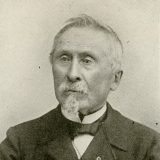Hybridizing Lilacs
In the 1800s French, Dutch, and German nurserymen were selecting, naming, and selling lilac cultivars. However, early attempts at breeding were accidental and involved a great deal of chance until French nurseryman Victor Lemoine (1823–1911) began his pioneering work in the 1870s.
Lemoine took a scientific approach by controlling pollination. He crossed the only known lilac cultivar to feature double flowers (those with more than four petals) with large-flowered varieties to create fragrant lilacs with large double flowers. Today all double-flowered lilacs are referred to as “French hybrids”—whether or not they were bred in France.
Another significant Lemoine innovation is Syringa × hyacinthiflora, which blooms about ten days earlier than common lilac. Lemoine created this hybrid by fertilizing Syringa vulgaris with the pollen of an earlier-blooming Asian lilac species (Syringa oblata). Lemoine’s nursery continued breeding lilacs for three generations, producing more than 200 cultivars, which became the foundation of lilac hybridization during the 21st century. Later lilac breeders began to utilize more Asian species, further enriching the diversity of lilacs available to modern gardeners.
Image courtesy of Longwood Gardens

